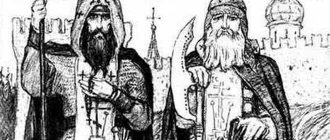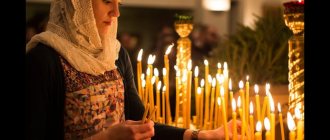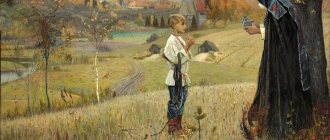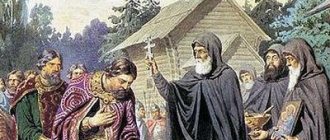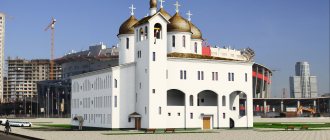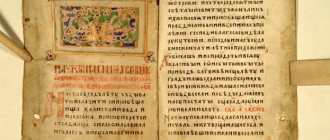| St. Cyril and Maria of Radonezh |
Cyril and Mary of Radonezh
(+ 1337), schema-monks, reverends, Khotkovo miracle workers, parents of St. Sergius of Radonezh Commemorated on January 18, September 28, in the Councils of the Radonezh and Rostov-Yaroslavl saints, on Thursday after the Sunday of the Publican and the Pharisee (local [1] )
There is no information about their parents, or about their childhood and adolescence, or about the time they entered into marriage. It is only known that they belonged to a noble boyar family. At the beginning of the 14th century, the righteous spouses of the boyars Kirill and Maria lived near Rostov the Great, in the small village of Varnitsa, where their estate was located. Kirill was in the service first of the Rostov prince Konstantin II Borisovich, and then of Konstantin III Vasilyevich.
More than once, boyar Kirill accompanied his prince on dangerous journeys to bow to the Golden Horde. Before leaving, they usually wrote a will and said goodbye to all their loved ones, since many Russian people there laid down their lives for the Orthodox faith. Mary, having seen her husband off, tearfully prayed to God for him and for their young son Stefan.
Saint Cyril owned a fortune sufficient for his position. The couple preferred a simple, secluded life on their estate to the bustle of the princely court. Living in the village, they did not neglect ordinary rural labor. Subsequently, in the place where, according to legend, the house of the Venerable Cyril and Mary was located, Rostov Archimandrite Ephraim founded the Monastery of the Life-Giving Trinity in 1427.
Once, during the Divine Liturgy, before the birth of her second son, righteous Mary and the worshipers heard the baby’s three exclamations before the reading of the Holy Gospel, during the Cherubic Song, and when the priest said “Holy to Holies.” Saints Cyril and Mary felt the great mercy of God; their piety demanded that feelings of gratitude to God be expressed in some external feat of piety, in a reverent vow. And righteous Mary, like Saint Anna, the mother of the prophet Samuel, together with her husband made a promise to dedicate their child to God.
The Lord gave them a son, who was named Bartholomew, the future Venerable Sergius of Radonezh. From the first days of his life, the baby surprised everyone with fasting: on Wednesdays and Fridays he did not accept his mother’s milk, but on other days, if she ate meat, the baby also refused milk. Noticing this, the Monk Mary completely abandoned meat food.
After Bartholomew, the righteous couple also had a third son, Peter. The couple raised their children in the Law of God, piety and chastity.
The righteousness of Cyril and Mary was known not only to God. Being strict guardians of all church statutes, they helped the poor, but especially sacredly kept the commandment of the Holy Apostle Paul about love of hospitable people (Heb. 13:2). They taught the same to their children, strictly instructing them not to miss an opportunity to invite a traveling monk or other tired wanderer to their home.
We have not received detailed information about the pious life of this blessed couple, but we can, together with Saint Plato, say that the very fruit that came from them - the great saint St. Sergius of Radonezh - showed better than any eloquent praise the kindness of the blessed tree.
Around 1328, the Monks Cyril and Maria moved from Rostov to Radonezh and settled there near the Church of the Nativity of Christ. Three versts from Radonezh was the Khotkovsky Intercession Monastery, which, given the lack of monasteries in the Moscow principality at that time, was both male and female. According to the widespread custom in Rus', simpletons, boyars, and princes accepted monasticism in old age. The spirit of monasticism was communicated from the son to the parents: at the end of their sorrowful life, the righteous Cyril and Maria wished to take on the angelic image themselves.
They directed their steps to this monastery, there to spend the rest of their days in the feat of repentance, preparing for another life. But the schema-boyars did not work for long in their new rank. In 1337 they departed to the Lord in peace. The children honored them with tears of filial love and buried them under the shadow of the same Pokrovsky monastery, which from that time became the last shelter and tomb of the Sergiev family. The youngest son of Saints Cyril and Mary, Peter and his wife Catherine, was subsequently buried here.
Life of the parents of Sergius of Radonezh
At the end of the 13th - beginning of the 14th century, 4 km from Rostov the Great, on the banks of the Ishni River, in the village of Varnitsa, there was the estate of the noble Rostov boyars Cyril and Maria (On the site of the estate of Cyril and Maria near Rostov there is now the Varnitsky Monastery).
Trinity-Sergius Varnitsky Monastery
Kirill was in the service of the Rostov princes - first with Prince Konstantin II Borisovich, and then with Konstantin III Vasilyevich, whom he, as one of the people closest to them, more than once accompanied to the Golden Horde. St. Cyril owned a fortune sufficient for his position, but due to the simplicity of the morals of that time, living in the countryside, he did not neglect ordinary rural labor.
Birth of Bartholomew, the future Sergius of Radonezh
The couple already had a son, Stephen, when God gave them another son - the future founder of the Holy Trinity Sergius Lavra, St. Sergius (in total, the couple had 3 children - Stephen, Bartholomew (the future Sergius of Radonezh) and Peter). Long before his birth, God's Providence gave a sign of him as a great chosen one of God.
According to legend, when his mother, pregnant with him, was in church, the child, to the great amazement of all those present, exclaimed three times in a loud voice in his mother’s womb. Firstly, at the beginning of reading the Gospel. Secondly, before the singing of the Cherubim. And finally, thirdly, at the moment when the priest exclaimed: “Let us take in, the Holy of Holies!” After this, the mother began to especially monitor her spiritual state. She constantly remembered that she was carrying a baby in her womb, who was destined to be the chosen vessel of the Holy Spirit. Maria observed fasting throughout her pregnancy, without giving herself any concessions.
Righteous Mary and her husband make a vow: if they have a boy, they will bring him to church and give him to God.
Baby Baptism
On May 3, 1314, great joy visited the righteous parents: a boy was born. On the 40th day after his birth, the Baby was brought to church to perform the sacrament of baptism on him. Priest Michael named the baby Bartholomew, for on this day (June 11) the memory of the holy Apostle Bartholomew was celebrated. This name in its meaning - “Son of joy (consolation)” was especially comforting for parents. The priest felt that this was a special baby and, overshadowed by the Divine Spirit, predicted:
“Rejoice and be glad, for this child will be the chosen vessel of God, the abode and servant of the Holy Trinity.”
Baby fasting
From the first days of his life, baby Bartholomew surprised everyone with his fasting. Firstly, on Wednesdays and Fridays he ate nothing at all. Secondly, on other days he refused mother’s milk if Maria ate meat. Abstained by fasting in the womb, the baby, even at birth, seemed to require fasting from the mother. And she began to observe fasting more strictly. First of all, I completely gave up eating meat. And even then the baby, except on Wednesdays and Fridays, always fed on her milk after that.
Difficulties with learning to read and write
When Bartholomew was 7 years old, his parents sent him to learn to read and write so that he could read and understand the Word of God. His two brothers also studied with him: the elder Stefan and the younger Peter. The brothers studied successfully, but Bartholomew was far behind them. The teacher punished him, his comrades reproached him and even laughed at him. Parents persuaded; and he himself strained all the efforts of his childish mind. Bartholomew spent his nights reading a book, and often, hiding from human gaze, somewhere in solitude, he wept bitterly about his inability. At the same time, he fervently and earnestly prayed to the Lord God:
“Give me, Lord, to understand this letter; teach me. Lord, enlighten and give understanding!”
But he was still not given a diploma. Until one day, sent by his father to the field to fetch horses, 13-year-old Bartholomew met an elder schema-monk. He asked him to come to his parents’ house; at dinner, the elder predicted to Cyril and Mary that “the boy will be great before God and people for his virtuous life.” Having blessed them, the schema-monk left. From then on, Bartholomew’s diploma, to his parents’ joy, began to come easily.
The parents of St. Sergius move to the Moscow lands
When Bartholomew turned 15 years old (around 1328), the Rostov Principality came under the rule of the Moscow Grand Duke Ivan Kalita. One of the Moscow boyars was appointed governor of Rostov, who oppressed and robbed the inhabitants. Many of the Rostovites began to leave the city. Among them was boyar Kirill. In addition to the oppression of the Moscow governors, he also went bankrupt, and did not want to stay where he once lived in wealth and honor. For his residence, he chose the small town of Radonezh in the Moscow lands (12 km from the Trinity Lavra, towards Moscow, there is the village of Gorodishche or Gorodok, which in ancient times bore the name Radonezh).
During the service, Mary heard the threefold cry of an unborn child
Mary and Cyril's son Stefan was already growing up, when a sign came to Mary that she was to give birth to a child of the Lord. While in church at the Divine Service, Mary heard the baby’s exclamation three times, that by the grace of the Lord she should give the light of God’s chosen one.
The Venerable Mary heard the baby cry three times
Inspired by the sign, Mary was especially sensitive to her spirituality. She protected herself and her family from filth, strictly observed fasting, and prayed to the Lord for a long time to preserve the child of God in her womb.
The parents of St. Sergius of Radonezh accept monasticism
According to the custom of that time, Kirill was supposed to receive an estate, but due to his old age he could no longer serve the Moscow prince. Therefore, his eldest son Stefan took over this responsibility. By that time he was already married. The youngest of the sons of Cyril and Mary, Peter, also got married. But Bartholomew continued his exploits in Radonezh. When he was about twenty years old, he asked his parents for a blessing to become a monk. The parents did not object, but asked to wait only until they died. After all, with his departure they would have lost their last support, since the two older brothers were already married and lived separately. The blessed son obeyed and did everything to appease the old age of his parents, who did not force him to marry.
Parents were tonsured into monasticism at the Intercession Monastery in Khotkovo
At that time, the custom of accepting monasticism in old age was widespread in Rus'. This is what simple people, princes and boyars did. According to this pious custom, Cyril and Maria, at the end of their lives, also first took monastic vows. But then the schema in the Khotkovsky Intercession Monastery. The monastery was located 3 km from Radonezh. At that time it was both a male and female monastery. Almost at the same time, a sad change occurred in the life of their eldest son Stephen. His wife died, leaving two sons. Having buried his wife in the Khotkovo Monastery, Stefan did not want to return to the world. Entrusting his children to his younger brother Peter, he became a monk here in Khotkovo.
Venerable Sergius at the relics of his parents
The death of the parents of St. Sergius
In 1337, schemamonk Kirill and schemanun Maria departed to the Lord. Before their blessed death, they blessed Bartholomew for his monastic feat.
The children buried them under the shadow of the Intercession Monastery. From that time on, it became the last refuge and burial vault of the Sergius family.
The reliquary with the relics of the Venerable Schemamonk Cyril and Schemanun Maria of Radonezh and Khotkovo Wonderworkers is currently in the St. Nicholas Cathedral of the Intercession Khotkovo Monastery
Relics of Saints Cyril and Mary in the Intercession Cathedral
Already being an abbot, the Monk Sergius often went from the monastery he founded (now the Trinity-Sergius Lavra) to the graves of his parents. And, according to legend, he commanded those coming to him to first pray for his parents in Khotkovo. This is how it has been since then. It became a tradition that before going to the Trinity-Sergius Lavra, pilgrims came to Khotkovo. Thus, wanting to “bow at the Intercession Monastery at the grave of his righteous parents. They did this in order to appear to the blessed son from his dear grave. Moreover, as if with parting words from the righteous parents themselves.”
Until the revolution of 1917, the relics of the saints rested under the floor of the Intercession Cathedral in the Khotkovsky Monastery. And after the liquidation of the monastery, the workers who were rebuilding it into warehouses and workshops... allowed the believers to take the relics and, moreover, they themselves helped open the floors of the temple and take out the remains. The relics were placed in a crypt on the territory of the monastery. Moreover, no signs or inscriptions were put on the crypt - only the direct participants in these events remembered the place...
Mary gave her word to dedicate the born child to the Lord
She made a vow in prayer to dedicate the baby to the Almighty and raise him according to Christian canons.
And on May 3, 1314, a boy, a blessed son, was born to them. On the fortieth day, the happy parents decided to bring him to church. Father Michael, who baptized him, named him Bartholomew.
Feeling that baby Bartholomew was special, he exclaimed:
“Rejoice, for this child is the chosen vessel of our God and the abode of the Holy Trinity.”
At baptism, the baby was given the name Bartholomew, fragment of the life
The elder predicted to Bartholomew that he would become special
One day a boy met an old man in a field. He invited the schema-monk to his parents’ house, and at dinner the elder predicted that Bartholomew would be great and virtuous before people and the Almighty. Having blessed the youth, the elder left, and from that time on Bartholomew began to easily read and write. He pleased his parents with his diligence and piety.
Fragment of life: Hospitality is one of the benefactors of Mary and Cyril
Saints Sergius, Cyril and Maria are considered intercessors against illnesses and disasters
The chronicle of the Intercession Khotkov Monastery testifies that prayer to St. Sergius and his parents saved people from serious illnesses. Reverends Maria and Cyril are considered intercessors in times of national disaster.
Thus, during the cholera raging in Russia, the monks from Khotkovo prayed to their intercessors, the Monks Mary and Kirill, for deliverance from the terrible illness. From August to December, the vigilant Psalter was read, water prayer services were read, and through prayers to the heavenly patrons the monastery got rid of a terrible illness. This was in 1770.
Pokrovsky Khotkov Monastery, where the holy relics of St. Cyril and Mary are kept
During a repeated outbreak of cholera in 1848, icons with prayer chants were carried around the cells, which miraculously helped to prevent the monks from getting sick.
Khotkovo Archpriest Alexy Lebedev talks about the miraculous healing of a peasant woman who fell into the river and fell ill with rheumatism. She lay bedridden for twelve long years.
On one of the long, painful nights, she dreamed of an old man in a robe, who told her to call upon St. Sergius and Mary and Cyril for help, and after blessing her, he disappeared.
Waking up, the peasant woman felt relief and began to pray day and night to the holy intercessors and the Lord. When she was able to walk, she went to the Intercession Monastery to venerate the relics and thank the patron saints Sergius, Maria and Cyril.
Saints Cyril and Mary of Radonezh, who gave Saint Sergius of Radonezh to Christians
The saints helped in establishing family relationships, in moral and spiritual education, and prayed to them for mental and physical healing, which they still pray for today.
Prayer to Saints Cyril and Mary:
“O servants of God, St. Cyril and Mary! Even though you have ended your natural temporary life in body, you do not depart from us in spirit; you guide us to Christ God, instructing us to walk according to the commandments of the Lord and to bear our cross and follow our Master. You, venerable ones, together with our reverend and God-bearing father Sergius, your beloved son, have boldness towards Christ our God and towards His Holy Mother of God. Be prayer books and intercessors for us, unworthy, living in your holy monastery, and you are its rulers. Be the helpers and intercessors of God's gathered squad, so that those who live in this place and come with faith, preserve by your prayers, remain unharmed from demons and from evil people, glorifying the Holy Trinity, the Father and the Son and the Holy Spirit, now and ever, and forever centuries. Amen".
By leaving a comment, you accept the user agreement
Saints Maria and Kirill and their sons are forced to move to Radonezh
Frequent Tatar-Mongol raids brought misery and poverty to Varnitsa. The principality suffered under the rule of Ivan Kalita. One of the Moscow nobles was appointed mayor to the Rostov lands, who continued to rob and oppress the local residents.
Rostovites began to leave the city. In his old age, Kirill and his family had to move to Radonezh. He was supposed to receive an estate and service from the Moscow princes. This responsibility was taken on by Cyril’s eldest son, already a family member, Stefan.
Reverend Kirill accompanied the Grand Dukes to the Golden Horde
Rus' has gathered
On August 18, Dimitri with Prince Vladimir of Serpukhov, princes of other regions and governors arrived at the Lavra. It was probably both solemn and deeply serious: Rus' really came together. Moscow, Vladimir, Suzdal, Serpukhov, Rostov, Nizhny Novgorod, Belozersk, Murom, Pskov with Andrei Olgerdovich - this is the first time such forces have been deployed. It was not in vain that we set off. Everyone understood this.
The prayer service began. During the service, messengers arrived - the war was going on in the Lavra - they reported on the movement of the enemy, and warned them to hurry up. Sergius begged Dimitri to stay for the meal. Here he told him:
The time has not yet come for you to wear the crown of victory with eternal sleep; but many, countless of your collaborators are woven with martyr’s wreaths.
After the meal, the monk blessed the prince and his entire retinue, sprinkled St. water.
Go, don't be afraid. God will help you.
And, leaning down, he whispered in his ear: “You will win.”
There is something majestic, with a tragic undertone, in the fact that Sergius gave Prince Sergius two monks-schema monks as assistants: Peresvet and Oslyabya. They were warriors in the world and went against the Tatars without helmets or armor - in the image of a schema, with white crosses on monastic clothes. Obviously, this gave Demetrius’s army a sacred crusader appearance.
On the 20th, Dmitry was already in Kolomna. On the 26th-27th, the Russians crossed the Oka and advanced towards the Don through Ryazan land. It was reached on September 6th. And they hesitated. Should we wait for the Tatars or cross over?
The older, experienced governors suggested: we should wait here. Mamai is strong, and Lithuania and Prince Oleg Ryazansky are with him. Dimitri, contrary to advice, crossed the Don. The way back was cut off, which means everything is forward, victory or death.
Sergius was also in the highest spirit these days. And in time he sent a letter after the prince: “Go, sir, go forward, God and the Holy Trinity will help!”
According to legend, Peresvet, who had long been ready for death, jumped out at the call of the Tatar hero, and, having grappled with Chelubey, struck him, he himself fell. A general battle began, on a gigantic front of ten miles at that time. Sergius correctly said: “Many are woven with martyr’s wreaths.” There were a lot of them intertwined.
During these hours the monk prayed with the brethren in his church. He talked about the progress of the battle. He named the fallen and read funeral prayers. And at the end he said: “We won.”
Some interesting facts
Several interesting facts are known about Sergei of Radonezh:
- While pregnant, the miracle worker’s mother went to the temple. During the prayer, her child in the womb cried out three times. Each time the volume of crying increased;
- According to sources, Sergei of Radonezh helped the monks. They were forced to go long distances to fetch water. The monk found a few drops left from the rain and said a prayer over them. After some time a source of water appeared;
- The miracle worker also helped ordinary people. A local resident turned to him with a request to save his sick son. The boy died after he was brought to Sergei of Radonezh. But while his father was walking behind the coffin, he incredibly came to life;
- The monk unfailingly helped every person who needed his support. It is known that he healed a possessed nobleman, treated the sick from insomnia and blindness;
- The Wonderworker provided assistance in reconciliation and salvation from debt.
Patriarch Kirill gave an interview about this in 2014. According to him, Sergei Radonezh had extraordinary abilities. He could influence the laws of nature and bring man closer to God. The historian Klyuchevsky stated that the miracle worker was able to raise the spirit of the people.
In order to see the relics of the saints, you need to get to the Intercession Monastery
To this day, their holy relics are located in Khotkovo, in the St. Nicholas Cathedral of the Intercession Monastery. The monastery is located at the address: Moscow region, Sergievo-Posadsky district, Khotkovo city, Kooperativnaya street, possession 2.
From Moscow you can get by train, departing from the Yaroslavsky station to Sergiev Posad, get off at the Khotkovo station. From the opposite side of the station, a bus leaves for the monastery. From the final stop it takes about 10 minutes to walk.
Official website of the Intercession Monastery in Khotkovo
More information about how to get there can be found on the official website of the monastery.

